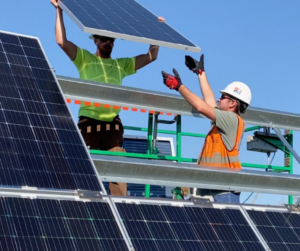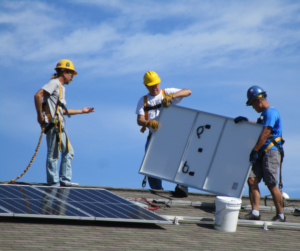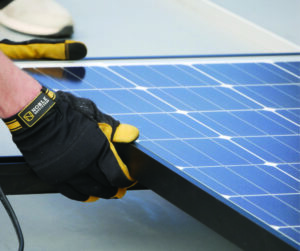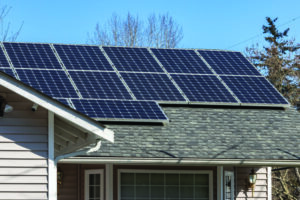Solar-Powered Potential
Harness the Sun’s Energy to Produce your Own Electricity
If you’re a homeowner in Northeast Wisconsin interested in the benefits of solar energy, it may not seem like the most ideal of environments for success and cost-savings—at first glance. We encounter long winters with shorter days in comparison to other areas of the country. We contend with extreme temperatures in the summer and winter, heavy snows and hailstorms that can wreak havoc on our properties.

But local experts say if you’re interested in the benefits of solar energy, there are many advantages to investing in it for your home—yes, even if you live right here in the Fox Cities.
“In fact, there are times of the year you can produce more power in Wisconsin than you could in Arizona, because the systems run more efficiently when the panels are cooler,” Pat Jensen, owner of Jensen Electrical Service, LLC explains. “The weather can actually help.”
Jensen, who is an instructor with Fox Valley Technical College, says even during times of the year when the sun is at a lower angle in the sky, a bright, sunny day and a reflection of sun off the snow can help produce more power here in Wisconsin than our friends in The Grand Canyon State.
But just how does energy from the sun get converted through solar panels into energy you can use in your home?
As Midwest Renewable Energy Association (MREA) Solar Program Manager Taylor Ball explains, the sun is shooting rays containing photons into the panels. The panes are made from an aluminum frame that has a semiconductor made of silicone underneath the glass. When the rays hit that semiconductor, and it shakes the electrons inside, that generates direct current electricity. In a typical solar system, that direct current then goes into an inverter, which is placed on the side of your home or inside your property depending on the site. The inverter is essentially like the brain of your solar system, and it translates that direct current from your panels into electricity you can then use in your home.
“There are just so many cool ways and avenues that folks can go to take control of their energy independence, and solar is just one of those great avenues,” she adds.

Sleek and Efficient Products an Improvement Over Previous Decades
The first several generations of solar panels, like any new technology, lacked a pleasing aesthetic. However, there are several products on the market today that are sleeker in appearance and certainly more efficient in how they harvest solar energy.
“Back in the 1970s they did a lot of solar heat systems that went on the side of people’s homes, and they were kind of ugly looking,” Jensen admits. “It kind of turned people off from it. [Now] there are different systems out there that can be put in the yard, on the roof and they can be integrated nowadays into the shingles on the roof.”
In deciding which product you’d like to see on or around your home, modules and panels are likely the best way to go for now for budgetary reasons. Jensen points out that the solar-powered shingles, known as photovoltaic shingles, take an extra step out of the normal process of installing traditional solar panels along a roof, but the upfront cost is greater and is something the homeowner will need to seriously consider.
“It’s a newer technology, meaning the cost is significantly higher compared to solar panels or solar modules,” reiterates Ball.
Caveats to Solar Panels and Modules
In homebuilder Brian Calmes’ experience, there aren’t many drawbacks to a solar panel system for the home or yard. He says it doesn’t make his job more difficult, but homeowners need to be realistic about the return on their investment from their system, and how long they’re planning to live in the home.
“The biggest thing is the return on the money—how much are they going to spend for the return?” he asks. “I believe normal systems last around 25 years… are you going to get enough savings in that 25 years to pay for the system, and then have to redo the system? In most of the calculations I’ve done, it’s pretty close. It really comes down to what kind of incentives they get from local and state government at the time, and there used to be a lot more.”

It’s also important for homeowners to assess the priority aesthetics will play in the system’s final place of installation. A homeowner may prefer the solar panels out of sight on their property or on the backside of a roof. However, if it’s in an area with heavy tree cover or other interference from neighboring properties, it’s not going to be as beneficial as if it might have been positioned in the front of the house on a south-facing roofline.
In other words, where you’d like to put the system—and where it needs to be positioned to produce its biggest bang for the buck—might be two very different areas.
Jensen cautions homeowners to understand installing solar panels is not a do-it-yourself project. Whether it’s the installation of a free-standing system in your yard, or you are using roof panels, he says the design of the system needs to be planned out to capture as much of the solar radiation as the site logistics allow. A site analysis needs to be done, including data like the location of the house on the property and a shading report, so the homeowner can ensure the design of the system will capture their needs. After the solar panel installation is complete, an electrician will need to shore up the electrical side of things.
“The key to this is there are solar installers out there who are not electricians,” Jensen stresses. “And there are electricians who are also solar installers. A solar installer can come to your house and put the solar panels system together, but they cannot integrate it into the electrical system without being a licensed electrician.
“A licensed electrician can do it all, but the solar installer can only do the mechanical solar piece of it.”
With a traditional system that is installed on your roof, Ball says the roof condition itself is also a consideration homeowners need to ponder.
“We typically advocate that if you’re about eight years away from getting your roof replaced, that you get your roof first before you get solar because of the longevity of these systems,” she says. “Typically, panels are warrantied for 25 years, but we see systems that are producing and living far longer than that—30 to 40 years.”

When trying to find an installation company for solar, ensure you’ve done your homework. Ball recommends finding someone who is a North American Board of Certified Energy Practitioner (NABCEP), as it’s the gold standard in the industry. Any reputable company should offer a free basic site assessment, be comfortable in educating you about the benefits of solar energy and your system, and be able to answer your questions, she advises. Do your homework and also check their Better Business Bureau rating.
Let the Sunshine In
There are several additional benefits to consider when making the investment in solar energy. If using clean energy is one of your priorities, solar panels are a low-maintenance product to use toward reducing your carbon footprint.
“Once it’s installed, it’s basically maintenance free,” Jensen explains. “There are no moving parts that you need to maintain, or oil and grease to check on. It basically sits there, and it just runs.”
Calmes adds that he hasn’t had any issues or complications with the solar installers he’s worked with on homes, and overall, the systems have a good reputation. He believes it also increases the resale value of a home, with the new owners presumably reaping the benefits of the solar power immediately, without the initial investment previous owners made.
“If you only made a little bit in the end, it’s still less of a carbon footprint, right? I would always probably advocate for the solar system on our homes—I wouldn’t advocate against them,” he says. “It’s probably worth [reducing] the carbon footprint.”
“The future is electric at this point, I truly believe that,” Ball says. “What’s great about solar is that it allows you to take control of your energy independence. You can now take the sun and create your own electricity.”

Solar Savings & Additional Resources
So, you know you want to reduce your carbon footprint and create your own electricity, but you’re not sure where to start?
Wisconsin’s Focus on Energy is a great place to start exploring rebates and incentives available to homeowners and renters for not just solar products, but the gamut of energy-saving projects and products.
In the realm of solar energy, Focus on Energy offers financial rebates to offset solar installation costs for your home or multifamily building:
- Residential customers can receive up to $500.
- Customers in specific ZIP codes may receive an additional $500 bonus.
- Solar on multifamily buildings can receive up to $50,000.
From a federal perspective, the Inflation Reduction Act extended the 30 percent tax credit available to homeowners as well. To understand exactly what benefits you can reap from those tax credits, be sure to ask your tax advisor what you can expect and what the tax credits will mean for your individual situation once your site assessment has been completed. This will give you a clearer picture of the exact financial investment and your returns.
For general information about the solar process, Wisconsin’s Midwest Renewable Energy Association has many resources, from general education materials to advice on selecting solar installers, and even a business member directory of vetted and certified companies. Visit https://www.midwestrenew.org/community-resources/ to start your education.
Powered by the Midwest Renewable Energy Association, Grow Solar is a coordinated effort among Midwest organizations and municipalities to build an open solar market that provides long-term benefits to communities. Visit growsolar.org for more information.











Leave a Comment